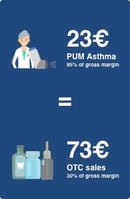With an open mind and great curiosity, we stepped into the first pharmacy three years ago in order to concretize our mission: get the people to be more involved in their own health. In the meantime, Salvus Health became an innovant player in the software industry thanks to our diverse team that excels at understanding the needs of the clients under our care. We learned to be wary of taking everything we hear on face value, and to use our critical thinking when faced with information given to us. Thus, we have for example realized that many pharmacists do not question the way they invest.
“MANY PHARMACISTS DO NOT QUESTION THE WAY THEY INVEST"
Today, the majority of pharmacists see their pharmacy as a retail business. They seek the increase of the volume, size or value of in-pharmacy transactions, or try to improve the team’s efficacity or the inventory management.
But, in this current context, when the selling of over-the-counter medication is under pressure (a trend that we do not see being overturned quickly), should we still consider a pharmacy as a retail business? Or are they becoming overtime service providers? And how does it change the current pharmacy Business Model?
Profit margins are declining in the Retail Model
There are different tactics known to enhance the rentability of a retail business. They mainly aim to either raise the income earned through the client’s shopping basket (for example by augmenting the size, frequency, or value of this basket), or to lower the exploitation costs (by gaining time or optimizing the stocks).
Many of these actions sadly lose their efficacity when faced with their lower profit margins. According to BDO, a well-known audit and consultancy firm, the Belgian pharmacies’ gross margins swing between 24% and 34%, while 20 years ago, they could easily reach 40%.
The service model, a fearsome competitor

A model based on services is quite different. The gross margins of 95% are common because the annual cost of the software (or material) often forms the only necessary “cost” to be able to offer the service.
This means that a PUM-asthma (Proper Use of Medication for Asthma) service billed 23€ makes you earn as much as 73€ of sold over-the-counter products or as five prescription-drugs’ deliveries (around 4.5€ for one delivery).
If we consider the investment this way, an effective asthma consultation lasting 5 minutes becomes a great alternative compared to the amount of time needed to sell 73€ worth of over-the-counter medications or to deliver five prescriptions.
But it is not all: the services offered by a pharmacy contribute much more to the patients’ satisfactions and loyalty than the single selling of products, because the latter are mostly not exclusive to a pharmacy and are available in many other sales outlets.
What’s striking is that the client’s loyalty is much stronger in the pharmacy sector than in most of the other retail sectors. And this is caused by the specific nature of the ‘chronic patient’ who needs life medication, and the impact that personalized pharmaceutical care can have on this loyalty.
Personalized pharmaceutical care
Pharmaceutical support is becoming more and more personalized when the medical and private situation of the patient is well known by the pharmacy team. A personalized approach creates noticeable results in the patient’s health right away, thus strengthening their loyalty.
Furthermore, patients with chronic illnesses will have to take medications their whole life. A loyal chronic patient then becomes a recurring client on which we can rely for the spending of the same amount each year at the pharmacy (according to our field research, one chronic patient generates a gross yearly margin of 1,250€ on average for one pharmacy).
This model shows a great advantage: it opens the door to a new growth strategy, in which the goal is for a maximum of chronic patients to be turned into loyal patients, instead of just selling more products.
The income deriving from the services can create sources of motivation for the team to focus on the development of those said services.
But the true potential for large-scale growth lies in the recurring revenue generated by chronic patients (medications + services).
We think that the size of the patients’ file’s relevance will likely increase in the future, especially when the pharmacies will be more paid by the government depending on the population they take care of, like the home pharmacist model or the general practitioner flat rate.

Recurring incomes
How do we then evaluate the investments in a pertinent way? It is before all about gaining more recurring patients in your pharmacy in order to start a “flywheel” (a self-sustained growth mechanism).
How many new chronic patients can you attract with the investments you are making?
With Salvus Health for example: If you can attract one patient who will stay loyal to the pharmacy for life, the 1,250€ CARE software license will then be permanently offset.
|
What can you already do today? Start by monitoring the following statistics :
- The number of loyal chronic patients in your pharmacy
- its progress (therefore, also its decline!)
- The average gross margin of chronic patients
|